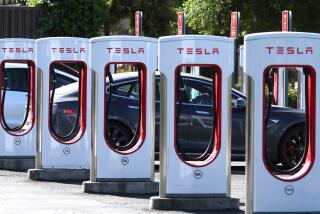More cash for clunkers
- Share via
After some initial resistance, the Senate appears poised to approve a House bill that would refuel the federal “cash for clunkers” program with $2 billion for additional subsidies. It may be the politically expedient move, but it’s the right one. The program is boosting economic activity at a time when consumer confidence has been slipping again, threatening to slow the economy’s nascent recovery.
Launched with $1 billion from the economic stimulus package enacted in February, the program offers new-car rebates to vehicle owners who agree to scrap a drivable car getting 18 miles per gallon or less. The rebate is $4,500 if the new car gets at least 10 more miles per gallon than the scrapped one; otherwise, it’s $3,500. (The program also applies to vans, trucks and SUVs, with different mileage thresholds.)
The rebates have been wildly popular, and why not? The program provides a windfall to car buyers with decrepit trade-ins. Dealerships love it too -- not only is it driving up sales, but the strong demand for rebate-eligible cars obviates the need for deep discounts. Critics argue that it makes little sense for the government to pay people to destroy things in order to buy new ones. They also note that car-buying tends to increase in the late summer without subsidies, as manufacturers and dealers try to clear out the current year’s models.
These are valid concerns, yet they don’t trump the benefits the rebates are providing to the economy as a whole. Auto purchases are important because they sustain not just manufacturers and dealers but a broad network of businesses that support them. Despite the popularity of foreign brands, more than half the cars purchased with the rebates were built in the U.S. Just as important, the rebates are prompting people to spend more money now, when the economy needs a boost. That spending, in turn, has delivered a jolt of positive economic news -- witness Tuesday’s report that Ford’s sales jumped in July, its first year-over-year increase since 2007. As icing on the cake, the average purchase has been yielding a 60% improvement in fuel economy (from about 15 mpg to 25), which helps justify scrapping cars that could still be driven.
That’s why it makes sense to provide more cash for rebates, with two caveats. Congress shouldn’t provide any additional money after the $2 billion -- it’s a temporary stimulus program, after all, not a new entitlement. And the money should come out of the initial $787 billion in the stimulus package. The administration estimates that only a fourth of the money will be spent in 2009 -- reason enough to shift funds into a program that’s working today.






